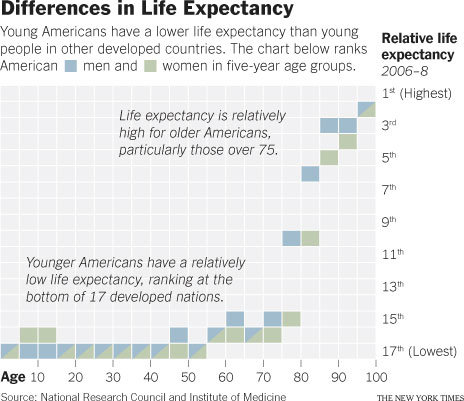The Institute of Medicine and the National Research Council released some damaging numbers this month: Americans ranks startlingly low in life expectancy, compared to 16 other similarly developed countries. This is especially true for younger Americans. Indeed, among people 55 and under, we rank dead last. Among those 50-80 years old, our life expectancy is 3rd or 2nd to last.
Sabrina Tavernise at the New York Times reports that the “major contributors” to low life expectancy among younger Americans are high rates of death from guns, car accidents, and drug overdoses. We also have the highest rate of diabetes and the second-highest death rate from lung and heart disease.
Americans had “the lowest probability over all of surviving to the age of 50.” The numbers for American men were slightly worse than those for women. Overall, life expectancy for men was 17 out of 17; women came in 16th. Education and poverty made a difference too, as did the more generous social services provided by the other countries in the study.
What isn’t making a difference? Apparently our incredible rate of health care spending.
Lisa Wade, PhD is an Associate Professor at Tulane University. She is the author of American Hookup, a book about college sexual culture; a textbook about gender; and a forthcoming introductory text: Terrible Magnificent Sociology. You can follow her on Twitter and Instagram.

Comments 21
The U.S. #1 in Early Deaths » Sociological Images | digitalnews2000 — January 24, 2013
[...] on thesocietypages.org Share this:TwitterFacebookLike this:LikeBe the first to like this. This entry was posted in [...]
Arne — January 24, 2013
Interesting. The incredible rate of health care spending might contribute to the fact that those over 80 are relatively well compared to other nations. I don't have data at hand but I remember vaguely my economics professor citing data that in Germany about 2/3 of the health care costs in a person's life occur during the last 10 years of said person's life.
Yrro Simyarin — January 24, 2013
Corollary: neither will switching to single payer medicine, an argument I have heard too many times.
Increased passenger rail might make a difference.
Mr. S — January 24, 2013
If one controls for automobile accidents and homicides, the US has the longest life expectancy in the world. We also have the highest cancer survival rates.
I think Arne's comment has it right with respect to health care spending.
Gman E Willikers — January 24, 2013
Much of this difference has a social derivative. The US has the highest caloric intake and is by far the most obese nation among the rich nations. Over half of the reason can be traced directly to this.
Mike — January 25, 2013
Maybe we should stop comparing the US to the rest of the OECD and instead group it with the middle inequality adjusted HDI nations?
Inequality makes the US look much more like a Latin American country than a European nation.
Emma Lloyd — January 25, 2013
The thing about the "incredible rate of healthcare spending" is that it's inflated by the cost of healthcare itself. The US has the most expensive healthcare system in the world, but that is not indicative of the quality nor of the value of care it provides.
In Some Categories THE U.S. #1 IN EARLY DEATHS | Welcome to the Doctor's Office — January 25, 2013
[...] from SocImages [...]
Kurt — January 26, 2013
I've seen reports that average U.S. life expectancy is the highest in the world after accounting for three factors: 1) auto accidents, 2) homocide, and 3) differences in infant mortality statistics calculation.
Auto accidents are primarily related to low population density leading to lots of driving (we aren't terrible on fatalities per million miles traveled), but improving safety technology--especially the possibility of fully or nearly fully autonomous vehicles--has reduced and will continue to reduce this factor.
Homocide is complicated, but some of the biggest factors have to be a broken education system, a deficient criminal justice and corrections system, and barriers to economic opportunities (occupational licensing restrictive zoning, anti-mobility policies).
On infant mortality statistics, the U.S. includes every baby born with any signs of life, no matter how young. Other countries don't count babies born prior to certain gestation thresholds or that don't survive for more than a minimum period of time. Fertility treatments are also more common in the U.S., leading to more multiple births, which are inherently greater risk.
Failing to compare apples to apples by not correcting for these things makes our life expectancy and by implication our health care sector seem worse than they are.
On the cost of health care, international comparisons are extremely misleading. Explicit (monetary) costs are higher in the U.S., but implicit costs like rationing, waiting periods, facility quality, and so on are much lower here. Other countries impose price controls to a greater extent than we do as well, which leads to additional implicit costs such as lower quality medical professionals. In addition, the U.S. bears far more than its share of medical innovation, letting other countries free ride on our R&D and business practice investments.
Chi di spada ferisce di spada (non) perisce « momatwork — February 13, 2013
[...] con una lunga aspettativa di vita). Come a dire, l’unico modo per non diventare vecchi è morire giovani. Un’altra cosa che ho notato, ma che forse è dovuta solo alla modalità di rappresentazione [...]